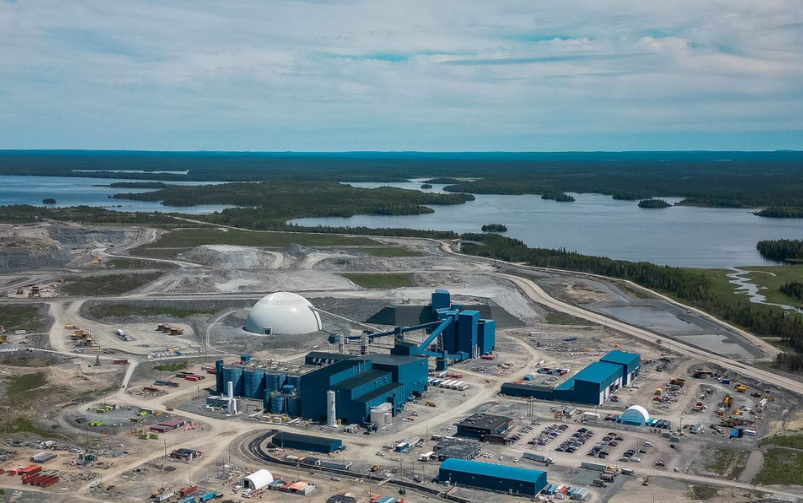Electra Battery Materials, based in Ontario, is one company in Canada that recycles black mass without relying on overseas processing. Courtesy of Electra Battery Materials.
The second episode of the Mission Critical webinar series from CIM Magazine and SGS Natural Resources took place on February 22 and zoned in on the development of Canada’s store of critical minerals. Co-hosted by Ryan Bergen, editor-in-chief of CIM Magazine, and David Anonychuk, global vice-president of metallurgy and consulting at SGS, the latest episode engaged several panelists in discussions surrounding the background and outlook for the battery recycling market, particularly in North America.
Anonychuk kicked off the episode by highlighting why battery recycling is such an important area of focus in the mining industry. “In order to meet the long-term battery raw materials supply challenge, and to meet those net-zero goals we think about for the long term, mining is not going to bring enough units to the market,” he explained.
Anonychuk turned the attention to Electra Battery Materials as a prime example of how black mass is being recycled within Canada, noting that the company is constructing North America’s sole cobalt-sulfate refinery.
Mark Trevisiol, vice-president of project development at Electra Battery Materials, explained that the company’s decision to shift to battery recycling came about when the company was putting together the proposal for its cobalt-sulfate plant. During presentations delivered before automotive manufacturers, such as Ford and General Motors, Trevisiol noticed that senior level management employees were posing questions about how the company would use recycled materials in their final product.
“There was that push, and we were also sitting on an asset that was operated as a hydrometallurgical site that produced cobalt and nickel products through hydrometallurgical processes,” he said. “There was the opportunity there to utilize some of the existing system processes in place to start taking things like black mass and see if we could profitably put the metals through processing.”
So far, Electra Battery Materials has processed approximately 40 to 50 tonnes of black mass and made its first customer shipment of nickel-cobalt produced from recycled battery material in 2023.
As for hurdles related to battery recycling within Canada and North America in general, Trevisiol outlined overseas shipments of black mass material as being one of the biggest current challenges in the market. “[Right now], there is nothing preventing people who recycle and make a black mass product from shipping that product overseas to be refined,” he said, adding that this was a sort of paradox considering that “our [federal] government is pumping billions into critical metal supply and encouraging investment in mines and processing facilities … and then on the recycling side, some of that [black mass material] is going overseas and ending up in China because there’s no regulatory framework to prevent that from happening.”
Sean De Vries, executive director at the Battery Metals Association of Canada, who has a background in electronics recycling, shared that when the country began introducing electronics recycling programs 25 years ago, Canada’s recycling market did have some existing recycling infrastructure in place, but it was still considered to be at a nascent stage. “I think electronics recycling and those programs came about as a result of some of the regulatory push, so that helped to really spark the boom of the industry and processing technologies,” he said.
De Vries offered an example of when electronic products would be recovered through smelters during these early days, and the challenges companies had to face when complex products were being sent into these smelters. “A whole TV can’t necessarily be recovered through one single process, so we have to divide the process up … and get [the products] to the right smelter so that you can recover the copper and the lead,” he explained. “You see this need to have specific recovering technology.”
Niels Verbaan, director of technical services (hydrometallurgy) at SGS, expanded further on the need for specific recycling technology, noting that there needs to be a key distinction made between scrap and end-of-life material.
“It is important to know that scrap recycling involves the reprocessing of materials that were produced now, today, or yesterday. It is today’s chemistry,” he said. In comparison, end-of-life material deals with chemistries that were produced a decade prior can result in feed material quite different from scrap. Verbaan noted that an argument could be made that scrap material is easier to reprocess than end-of-life material. “If you want to process that back into the current battery chemical producers, that means you’re going to have to separate these into their individual components, and that leads to an additional degree of difficulty.”
Trevisiol underpinned the important role that the Canadian government plays in the country’s battery recycling processing, noting that there needs to be more regulations set in place to address materials being shipped offshore. “Otherwise, it’s a paradox,” he said. “You’re pumping money into extracting these critical minerals and then they’re being sent [to be processed] elsewhere.” He referred to the U.S.’s Inflation Reduction Act as an example of how Canada can improve its recycling regulations, explaining that the act requires North American EV manufacturers to have most of their battery components processed, refined, and manufactured within the continent.
A recording of the webinar can be found on CIM’s YouTube channel.




